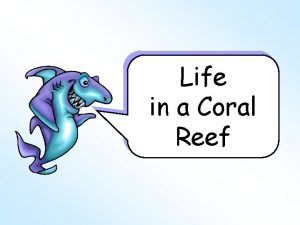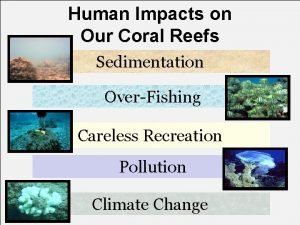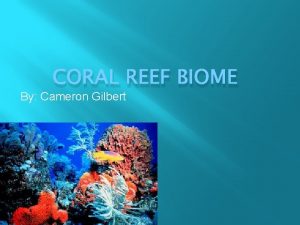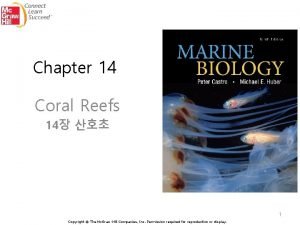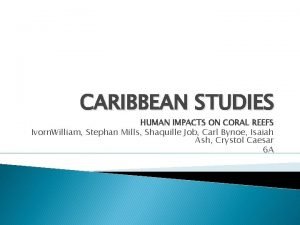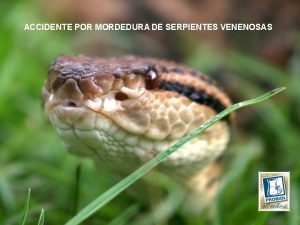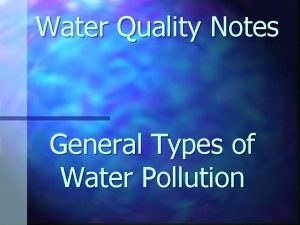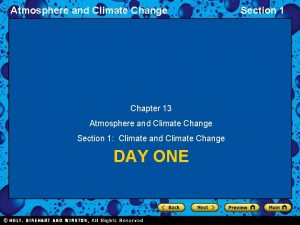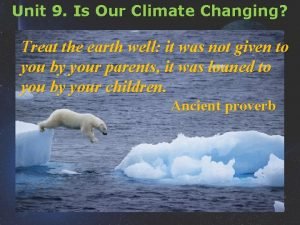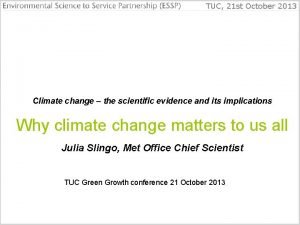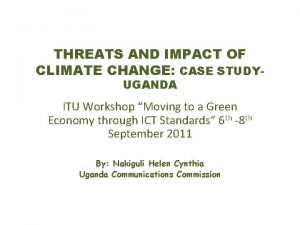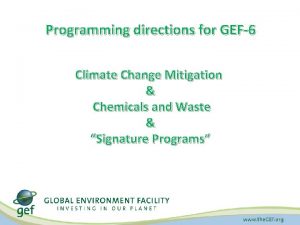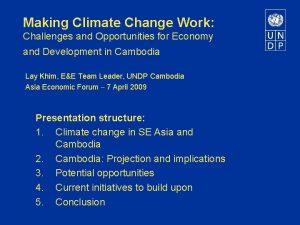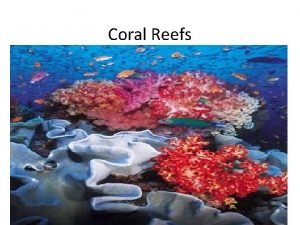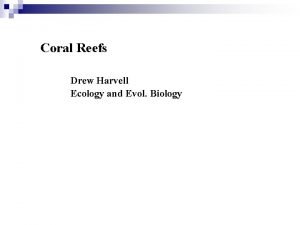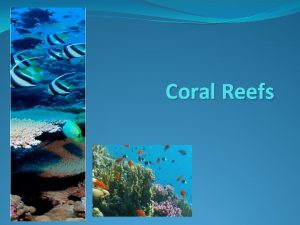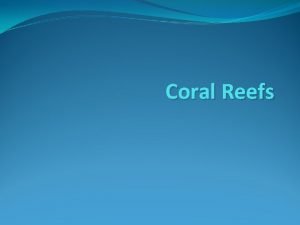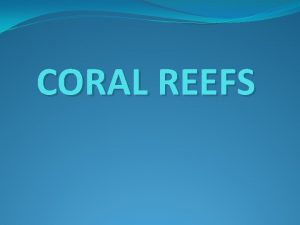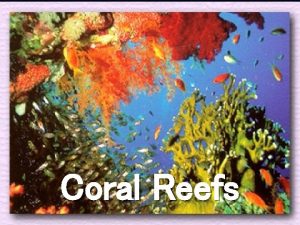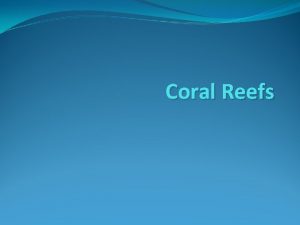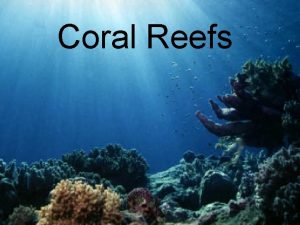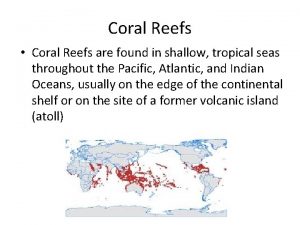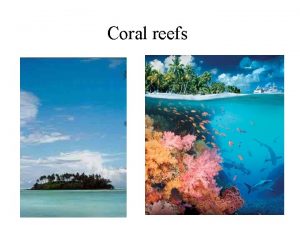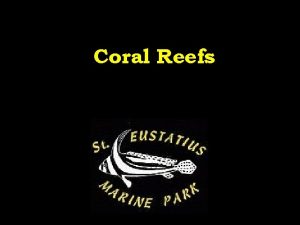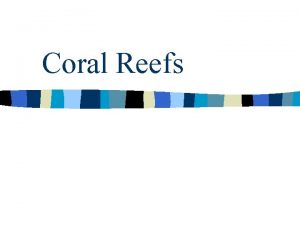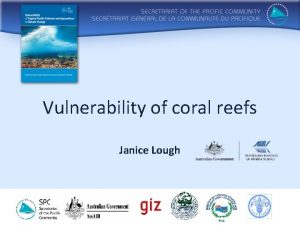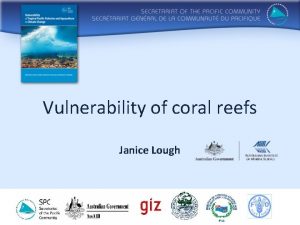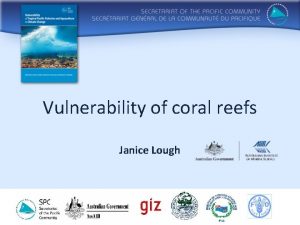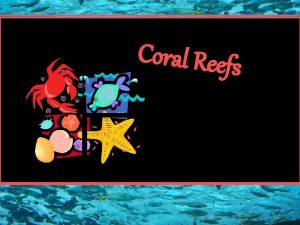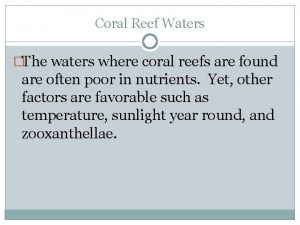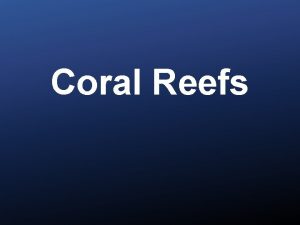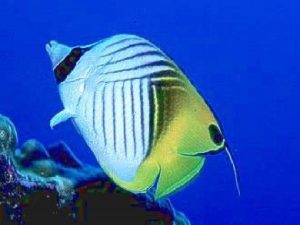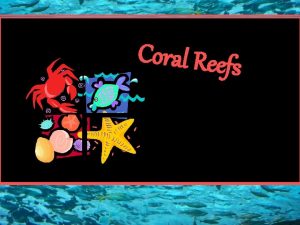Coral Reefs and Climate Change Drew Harvell Ecology



























- Slides: 27

Coral Reefs and Climate Change Drew Harvell Ecology and Evolutionary Biology Cornell University

Disease is a major community structuring agent in the ocean • Coral diseases-- eg Acropora spp over 90% mortality mid 1980 s • Tropical urchins-- eg Diadema over 90% mortality mid 1980 s well documented keystone effect of disease • Temperate urchins • Lobsters, other crustaceans, oysters, abalone

Sea Urchin (Diadema antillarum ) Die-Off • • started in January, 1983 population density reduced by 97% in one year (Lessios 1988) current population density still <3. 5% of 1983 (Lessios 1995) major community shifts on coral reefs > coral to algae dominated • unidentified water-borne pathogen Photo by P. Humann

Corals-- a colonial invertebrate

Ocean diseases and climate warming: explosive mix • • • corals at upper thermal limits, eg bleaching pathogens can rapidly evolve new > temp tolerances pathogens evolve much more rapidly > than coral anthropogenic activities increase stir in more new emergent pathogens


White Band Disease of Corals • Acropora cervicornis dominated Caribbean Coral Reefs • from 1950 -1970—disappeared thereafter • Mass mortality from White Band Disease in Belize in 1986 • First time in 3, 800 years (Aronson & Precht 1997)

Warming Oceans Can Facilitate Pathogens • Black band disease of coral increases in summer • Aspergillosis of coral grows faster at peak summer temperatures • Perkinsus of oyster moved to Maine when winter temps warmed in the 90 s • Coral bleaching likely facilitates disease Florida Keys: 63% died during warm El nino

Seafan-aspergillus epizootic 1 - Impact in the Keys 2 - Spatial. Ecology 3 - Resistance to Disease

Aspergillosis of Sea Fans ~ Dynamics in the Florida Keys ~ • Are there disease hotspots correlated with water quality? > Prevalence: number of infected individuals > Virulence: damage from disease > water quality: temperature, nitrates, chlorophyll a, etc. • Can sea fans fight back? > chemical resistance • Could chemicals from soft corals have biomedical applications? > anti-bacterial compounds (Jensen, Harvell, Wirtz, Fenical 1996) > antifungal compounds (Kim, Harvell, 2000)

Death of a Diseased Coral Alisa Alker


Seafan Disease Monitoring Permanent Transects Established June 1997 Currently 8 sites along the Florida Keys Three 25 m transects per site Parameters measured Colony height (cm) % infected individuals: Prevalence % colony damage: Severity Dead

June 1997: Hi prevalence, variable severity-- compromised resistance more important than transmission? Kim and Harvell in press

New disease and force of infection. Mortality Hotspots-indicator of disease process scale?

Seafan Corals: Impact of a Fungal Disease Aspergilli cause diseases in immune compromised hosts. Is resistance of seafans compromised? K. Kim photo

Seafan Resistance to Aspergillus • Antifungal chemicals • Hyperplastic tumors • Melanization response NSF, NOAA

Aspergillus sydowii : optimal temp is hot 8 6 Growth Rate (mm/d, ±SE) 4 2 20 25 30 Temperature (˚C) 35 40 Alker et al

Antifungal Activity in Gorgonian Corals (Kim et al, 2000) Minimum Inhibitory Concentrations (mg/ml) 20 15 10 increasing activity Pseudopterogorgia acerosa Pseudoplexaura wagenaari Pseudoplexaura flagellosa Pseudoplexaura porosa Pseudopterogorgia americana Gorgonia ventalina Plexaura kuna Eunicea succinea Pseudopterogorgia bipinnata Plexaura flexuosa Plexaura homomalla Pterogorgia citrina Briareum asbestinum Erythropodium caribaeorum Pseudopterogorgia rigida Plexaurella grisea Plexaurella nutans Muricea atlantica Muriceopsis flavida Pterogorgia guadalupensis 5

K. Kim


Time course of induction



July 99

Your Test • Will the fungus cause seafan exinction? • Need to know: coral mortality rate, longevity, recruitment rate… • …it could because mortality hi, long-lived, and no repro • Is climate warming a threat to corals? • BIG THREAT • Where might new coral diseases come from? • Aquaculture, land, ballast shipping, existing pathogens • Can seafans fight back? • Rapid induction (4 -8 days) • Antifungal chemicals, melanin (purpling), gorgonin tumors • Will seafans evolve to be more resistant? • Maybe, clonal variation for selection to act on.

Diseases in Marine Communities ~ Changing Perspectives ~ Predation Competition Predation Abiotic Factors Competition Disease Corals Abiotic Factors
 Climate change 2014 mitigation of climate change
Climate change 2014 mitigation of climate change Coral reef food web
Coral reef food web Does overfishing affect coral reefs
Does overfishing affect coral reefs What is a coral reef biome
What is a coral reef biome Competition in coral reefs
Competition in coral reefs Fringing reef
Fringing reef What is the last step in the formation of an atoll?
What is the last step in the formation of an atoll? Coral reefs caribbean studies
Coral reefs caribbean studies Detailed lesson plan about coral reefs
Detailed lesson plan about coral reefs Viperidae y elapidae
Viperidae y elapidae Type of reefs
Type of reefs Climate change meaning and definition
Climate change meaning and definition Chapter 13 atmosphere and climate change section 1
Chapter 13 atmosphere and climate change section 1 Chapter 13 atmosphere and climate change
Chapter 13 atmosphere and climate change Persuasive essay about global warming
Persuasive essay about global warming Karnataka state action plan on climate change
Karnataka state action plan on climate change Climate change brainpop
Climate change brainpop Unit 9 climate change
Unit 9 climate change Conclusion of climate change
Conclusion of climate change Conclusion of climate change
Conclusion of climate change Conclusion of climate change
Conclusion of climate change Mathematics of climate change
Mathematics of climate change Climate change definition ap world history
Climate change definition ap world history Climate change mitigation
Climate change mitigation 414 climate change
414 climate change Conclusion of climate change
Conclusion of climate change Factors of climate change
Factors of climate change Conclusion of climate change
Conclusion of climate change

